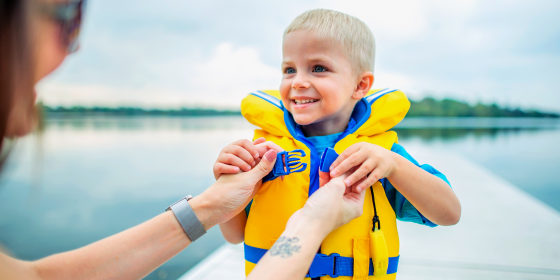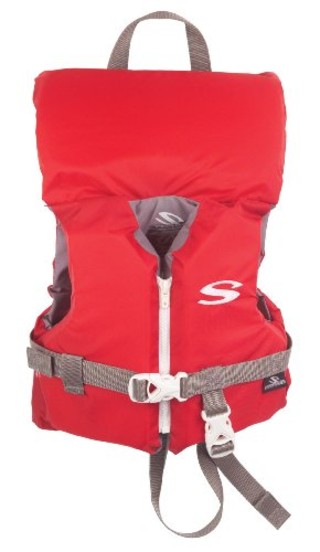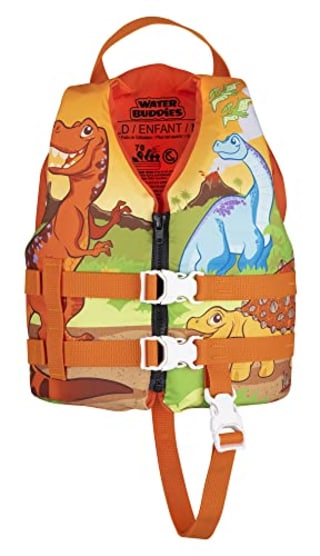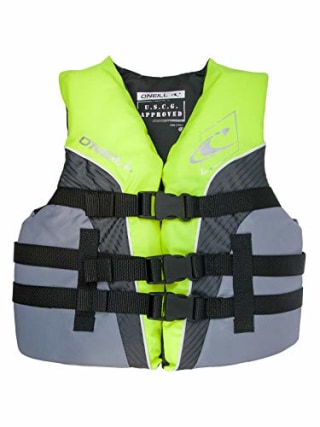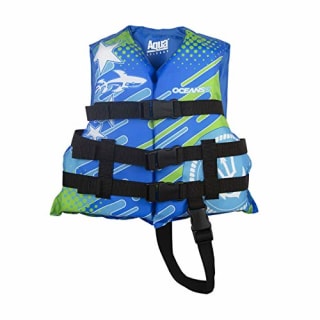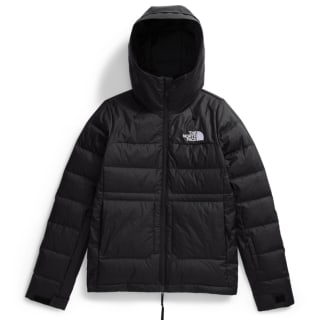For many families, summer is synonymous with spending time near or on the water. And while having fun with your kids may be top of mind when you head to the beach, lake or pool, safety is also an important factor to keep in mind. Drowning is the leading cause of death in children between the ages of 1 to 4 years old, according to the Centers for Disease Control and Prevention, but there are preventative measures you can take to keep your children safe. Along with teaching your children basic swimming skills, the CDC says that wearing a life jacket (also called a personal floatation device or PFD) can reduce the risk of drowning for children of all ages. “Consider wearing a life jacket on a boat or near open water akin to wearing a seatbelt in the car,” says Peg Phillips, executive director of the National Safe Boating Council.
SKIP AHEAD Top-rated life vests for kids | How to make sure your child’s life vest fits properly
To help you find a life vest suitable for your child, we talked to Phillips and other water safety experts about what important features you should look for when you shop. We then used those guidelines to round up highly-rated life vests for kids of different ages.
Our top picks
- Best overall: Oceans 7 Life Vest
- Best infant life vest: Stearns Infant Classic Series Life Vest
- Best child life vest: Airhead Wicked Kwik-Dry Neolite Flex Life Jacket
- Best youth life vest: O’Neill Youth SuperLite Life Vest
How we picked top-rated life vests for kids
To compile a list of top-rated life vests for kids, we spoke to two water safety experts about the key factors to keep in mind when shopping. The experts we spoke to recommend you consider the following factors:
U.S. Coast Guard approval: Any life vest you buy should be approved by the U.S. Coast Guard (USCG) — this means that it has been through vigorous testing to ensure it’s buoyancy and effectiveness, says Phillips, who adds this approval can be found printed on the inside of life vests. Every option in our round-up is approved by the USCG.
Type: There are five different types of life jackets:
- Type I: These are the most buoyant but can be very cumbersome. The USCG recommends these for people who will be doing activities like boating alone.
- Type II are also very buoyant, making them a good option for children who do not know how to swim.
- Type III offer moderate buoyancy and are comfortable to wear for longer periods of time, according to the USCG.
- Type IV are throwable devices that are intended to be tossed to someone who has fallen overboard to help them stay afloat.
- Type V are intended for special use during activities like white water rafting.
In this round-up, we focused on type II and III life vests.
Size: Making sure your child’s life vest fits properly is key to it helping them stay afloat. When it comes to sizing, the USCG breaks life vests into four categories:
- Infant vests: suitable for babies up to 33 pounds
- Child vests: suitable for babies and kids between 33 and 55 pounds
- Youth vests: suitable for children between 55 and 88 pounds
- Adult vests: suitable for anyone over 88 pounds.
We have included options in each size range to ensure there is a top-rated recommendation that will work for your child.
Top-rated life vests for kids
Below, we rounded up top-rated life vests for kids of all ages based on guidance from the experts we talked to.
Airhead Wicked Kwik-Dry Neolite Flex Life Jacket
4.8-star average from 1,187 reviews on Amazon
This life vest comes in infant and child sizes and has a strap that goes between your child’s legs to help it fit properly. “The leg strap will help keep the life jacket from being pulled over the child's head when they are in the water,” says Phillips. Both sizes come with a strap at the shoulder (often called a grab handle), which Phillips says can help a parent retrieve a child if they fall in the water. The infant version has a float collar, too. This is a key element for babies because it can help keep their head upright and above water, something infants may have a hard time doing on their own, says Phillips.
U.S. Coast Guard Approved: Yes | Size: Infant and child | Type: Type II (infant) and Type III (child)
Stearns Infant Classic Series Life Vest
4.7-star average from 5,554 reviews on Amazon
This infant life vest has a float collar to keep a baby’s head up in the water, a grab handle and a leg strap to help ensure a proper fit. The nylon shell is durable and treated with an antimicrobial coating to help the life vest resist odor, mildew and fungi, according to the brand.
U.S. Coast Guard Approved: Yes | Size: Infant | Type: Type III
Full Throttle Child Water Buddies Life Vest
4.7-star average from 1,321 reviews on Amazon
I have a two-year-old, and when we bring her to our family’s lake house, getting her to put on a life vest can be a struggle. I’ve found that when a vest has a fun character or design, she’s more likely to slip it on willingly. This child-sized option comes in a dinosaur, lady bug, princess or turtle print. The vest comes equipped with a zippered front, two buckles across the chest and waist and a leg strap to prevent it from riding up when in the water.
U.S. Coast Guard Approved: Yes | Size: Child | Type: Type III
O’Neill Youth SuperLite Life Vest
4.5-star average from 1,051 reviews on Amazon
Sized for kids between 50 and 90 pounds, this life vest from O’Neill is designed to fit snugly for safety, according to the brand. Because this life vest is intended for older children, it doesn’t not come with a leg strap. It also has strategically placed drain holes so it doesn’t retain water and make the vest heavier, says O’Neill.
U.S. Coast Guard Approved: Yes | Size: Youth | Type: Type III
Oceans 7 Life Vest
4.6-star average from 6,175 reviews on Amazon
This life vest comes in sizes that will accommodate the whole family. It has an open side design — the area directly under the armpit does not have any padding — which makes this vest more comfortable to wear for longer periods of time, according to the brand. The infant and child size come with a leg strap for a snug fit. The nylon material used is also quick drying, according to Oceans 7.
U.S. Coast Guard Approved: Yes | Size: Infant, child, youth, adult | Type: Type II (infant), Type III (child, youth, adult)
Stohlquist Fit Youth Life Jacket
4.6-star average from 4,898 reviews on Amazon
This life vest has low-cut arm holes to let you move more freely and a thinner back panel so you can sit more comfortably in high back seats on a boat, according to the brand. The three buckles are all secured to the life vest using box-stitched webbings, which Stohlquist says is the most durable type of stitch that can be used. This vest also features a grab handle, which our experts recommend to help adults pull kids out of the water if necessary.
U.S. Coast Guard Approved: Yes | Size: Youth | Type: Type III
Hardcore Sports Life Jacket
4.6-star average from 3,072 reviews on Amazon
If you have a teenager who is a capable swimmer, they may not want to wear a life vest every time they are around water. But if they are engaging in watersports or going on a boat, experts still recommend they wear a life vest, even if they know how to swim. This vest should fit anyone who wears an adult small, medium or large shirt size, says Hardcore Sports. The completely open sides on this vest provide a more breathable fit and allow for more mobility when engaging in water sports, according to the brand.
U.S. Coast Guard Approved: Yes | Size: Child, Youth, Adult | Type: Type III
How to make sure your child’s life vest fits correctly
For a life vest to work properly, it must fit. And while all of the life vests on our list come with size guidelines, you shouldn’t only rely on what the tag says. You need to try the life vest on your child to really make sure it fits, says Phillips.
But how exactly should a life vest fit? “It should be snug, but not too tight,” says Rachel Griffiths, communication director for the Aquatic Safety Research Group. “And it’s important that the life vest can zip and that all the buckles can be closed.” If your child is in an infant or child-size life vest, their vest will come with a leg strap that runs from the back of the vest, between their legs and buckles at the front of the vest. Don’t skip this buckle. “It is especially important if a child is floating, as the buoyancy of the life jacket may lift it up — that strap will help keep the life jacket where it is supposed to be,” says Phillips.
To make sure that life vest fits properly, Phillips suggests the following test: Tighten all buckles and straps, then place your fingers under the shoulder straps and gently pull up. If the life vest can easily be pulled above the ears, it is too loose.
When should a child wear a life vest?
For the most part, the decision to put your child in a life vest is up to a parent or guardian's discretion. Factors like proximity to water, type of water, age and swimming ability can influence the decision. There is one exception to this rule: The U.S. Coast Guard mandates that all children under the age of 12 must wear a life vest while on a boat or any other type of vessel that is on the water. For anyone over that age, they do not have to wear the life vest, but there must be one for them on board.
Children who either cannot swim or are new to swimming should be outfitted with a life vest anytime they are in a pool, says Griffiths. Swimming in open water — like the ocean, a lake or river — can be challenging for even more experienced swimmers due to things like waves, tides and currents. Because of this, Phillips suggests that all children wear a life vest when swimming in open water. “And if a small child is on a dock, it is smart to put a life jacket on them,” says Phillips, who notes that it will protect them if they fall in the water or if you take your eyes off them for a minute ,and they decide to jump in.
Do not use floaties as a substitute
Inflatable arm floaties are popular, but they should not replace a life jacket. Floaties “are not a substitute for approved life jackets and can give children and parents a false sense of security,” says guidelines from American Academy of Pediatrics (AAP). It is not uncommon for them to slip off a child, and you cannot count on them as an effective layer of protection, says Griffiths.
Meet our experts
At Select, we work with experts who have specialized knowledge and authority based on relevant training and/or experience. We also take steps to ensure all expert advice and recommendations are made independently and without undisclosed financial conflicts of interest.
- Peg Phillips is the executive director of the National Safe Boating Council
- Rachel Griffiths is the communication director for the Aquatic Safety Research Group and the president of the Note and Float Life Jacket Fund
Why trust Select?
Bethany Heitman is a contributor at NBC Select and a journalist who regularly covers topics like beauty, home and lifestyle. For this story, she interviewed two experts to gather their guidance on what to look for when shopping for life vests for kids.
Catch up on Select’s in-depth coverage of personal finance, tech and tools, wellness and more, and follow us on Facebook, Instagram, Twitter and TikTok to stay up to date.

